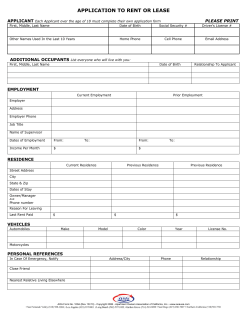
Document 183141
The research proposal must be of the following structure: Table of Contents, Abstract, Introduction into the General Topic, Problem Statement, Hypothesis and Objectives of the Study, Literature and Research Review, Research Methodology, Data Collection, Analysis and Evaluation of Data, Expected Results and Output of the Study, Biblio-graphy, Appendix (Tables, Graphs, Questionnaires), Financial Budget and Timetable. With the scholarship application the following issues will have to be covered respectively the following documents will have to be handed in: Research proposal, 2 Letters of recommendation by researchers from applicants field, Statement of the home university, Correspondence with Scientific Supervisor and formal agreement on supervision in Germany in detail (confirmation on the use of laboratory equipment, materials etc.), C.V. (focusing on educational and scientific background: Publications, Conferences, Teaching experiences etc.). DAAD Information Center Accra 30, Kakramadu Road, East Cantonments Located at Goethe-Institut, next to NAFTI Tel. +233 302 760342 or +233 302 784865 daadghana@yahoo.com http://www.ic.daad.de/accra facebook.com/daad.ic.accra Office Hours Mon. 3.30pm – 6.30pm Fri. 2.30pm – 6.30pm Consultation at the German Embassy: Tue. 10.00 – 12noon Introductory Sessions on Study & Research in Germany: 1st Thursday of every month from 4pm – 6pm At the Goethe Institut. Participation in this session is mandatory prior to individual consultation. April 2011 Edition www.ic.daad.de/accra How to write a research proposal Information Center Accra How to Write a Research Proposal The following recommendations do not guarantee a successful research application. They may, however, help the applicant prepare a carefully conceptualized and comprehensive proposal. The purpose of the proposal is to ensure that the candidates have done sufficient preliminary reading and research in the area of their interest, that they have thought about the issues involved and are able to provide more than a broad description of the topic which they are planning to investigate. They have to convince members of the scientific community that they have identified a scientific problem as well as that they have the theory background and methodical approach that will enable them to solve the problem within a realistic time frame and at reasonable expenses. The research proposal should have between 10 and 30 pages. It should have a proper layout (typeface and line spacing) as well as a table of contents and page numbers. On the title page, personal information has to be stated like applicant’s name, academic title (if applicable), current position at the university, date of birth, nationality, work and private address including telephone and e-mail address. Then the title of the planned dissertation (or research report) and a realistic time frame in which the project should be completed should follow. After this comes the name of supervisor(s), the university department which will host the researcher and, if applicable, information about other academics with whom the researcher plans to collaborate. A short statement on the research topic that has been identified, not more than one page, should focus on the new, current and relevant aspects of the topic. It is advisable to choose a topic which can be researched through appropriate and valid methods and for which research material is available. In the Literature Review a short and precise overview about the current state of research that is immediately connected with the research project should be given. The most important contributions of other scientists should also be stated. The proposal should contain a clear and logical discussion of the theoretical scope OR the framework of ideas that will be used to back the research. It needs to show that the applicant is fully conversant with the ideas he is dealing with. The research review must indicate an open problem which then will be the motive for the project and state clearly how it will contribute to the existing research. The most important results of the applicant’s work on the topic should be summarized. Copies of the applicant’s publications that might be seen in connection with his research project might be attached. A concise and clear outline of the academic objectives that shall be achieved through the project must be given. The proposal needs to show why the intended research is important and to justify the effort of doing the research. Such justification may either be of an empirical nature or of a theoretical nature. The outline of the project is the central part of the research proposal. It may well fill half of the space of the proposal. It should give detailed in- formation about the intended research procedure during the given time, about the sources and quality of evidence, the analytical technique and the timetable for the project. Depending on the topic, suitable research strategies should be defined to ensure that enough and adequate empirical data will be gathered for a successful research project. The intended methods of data gathering, the controls that will be introduced, the statistical methods to be used and the type of literature or documentary analysis will have to be outlined. However, one should be ready to revise the proposal according to new insights and upcoming questions and keep on modifying the working hypothesis. Information about the estimated time table should indicate the sequence of research phases and the time that will probably be needed for each phase ( if possible in tabular form). In the selective research bibliography those academic works will be listed which have been mentioned in the research outline as well as a number of other important works to which the applicant will refer during the research should be listed. Once the conceptual work on the proposal is finished, a careful editing stage should follow
© Copyright 2025





















